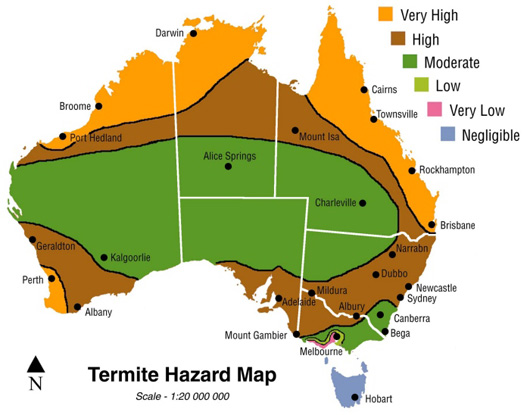There is a common saying that there are only two different types of houses in Australia – the ones that already have termites and those that will eventually get them. At Stoddart Group we know there’s another to add to the list, those with a steel house frame. Termite infestations are becoming increasingly common across Australia and are responsible for more damage to houses in Australia each year than fires, floods or storms (Victorian Building Authority). Concealed in locations that often go undetected, termites destroy timber internally, leaving only a wafer-thin layer to protect them from the outside environment. There is no predictable pattern or height restriction to their damage, with termite-infested sites found in roofs and even high-rise constructions.
A survey conducted by CSIRO reveals that roughly one out of three Australian residences have termites living on their property, making these insects a huge issue here in Australia. Research conducted by the National Association of Steel Framed Houses Inc estimates the annual cost of termite damage in Australia to vary between $80 to $780 million, causing many home owners to face losses of tens of thousands of dollars in damage.
Considerations and Warnings
- Sometimes termites, which are known as "white ants", are confused with ants, but they're different. One difference is that ants have eyes, while termite workers and soldiers do not. Furthermore, ants have a distinct waistline between their abdomen and thorax, but termites do not have a waist.
- Even though there are more than 250 different termite species just a few of them create significant issues for Australian properties such as the Coptotermes Acinaciformis and the Schedorhinotermes Intermedius
- Termites are extremely secretive, entering structures via areas, such as through expansion joints, concrete slab cracks and other spots that are out-of-reach to inspection.
- Home or Building Insurance Policy will NOT cover remedial and repair costs of damage caused by termites to structural and decorative timbers in a building.
- As mentioned previously, the damage to unprotected homes can be substantial and the repair bill enormous, ranging from an average cost of $7000 to over $100,000 in more severe cases (Building Connection).
- As well as structural timbers, termites can also chomp their way through furniture, paper products, fabrics, clothing, footwear and even non-cellulose materials like soft plastics, building sealants and rigid foam insulation (Choice).
- To protect themselves from predators, heat, light and the humidity of the outside environment the worker termites make tunnels to travel back and forth between the nest and the feeding ground (where the damage is caused). Tunnels can be 400 mm deep and 150 metres in radius, with the nests sometimes being up to 100m away from where the workers are foraging.
With our growing love of landscaping in modern times, the abundant use of bark, wood chips and mulch, timber retaining walls and pergolas has created a haven for termites in our backyards which has hugely increased the presence of termites on residential properties. To most people, their most important asset is their home, therefore, it is important to ensure termite protection is a priority for every builder and homeowner.
Our Steel Framing is 100% termite free and gives homeowners the comfort of knowing their home is protected from these silent destroyers for years to come. Superior to timber in many ways and cost-competitive, steel framing is a must-have option for modern builders.
Want more information on our Steel Framing solutions? Head to Steel House Framing.
Sources used:
https://nash.asn.au/nash/structural-pests/latest-research
https://www.daf.qld.gov.au/business-priorities/forestry/pests-and-diseases/termites
https://termitesonline.com.au/termite-statistics-for-queensland-and-australia/
http://www.vba.vic.gov.au/consumers/termites
https://australianmuseum.net.au/termites
https://www.aboveboardbuildinginspections.com/blog/a-full-guide-to-termites-in-australia/
http://termi-mite.com.au/Termite-Types-and-Risks.html
https://www.fumapest.com.au/pdf/Termite%20Incidence%20Survey%20-%20Termite%20Hazard%20Map.pdf
https://buildingconnection.com.au/2016/07/25/preservative-treated-timber-for-termites/



